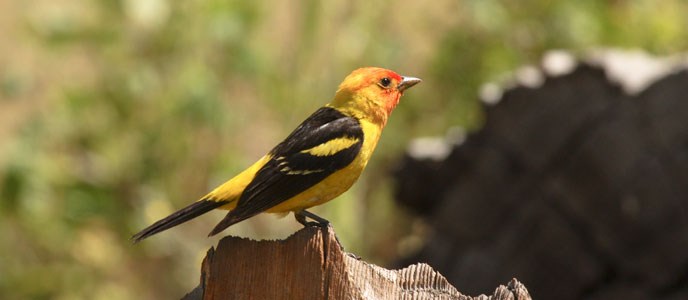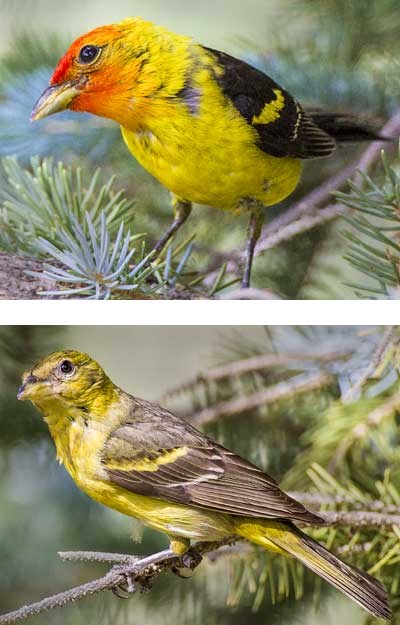
NPS 
Bottom: Females are brown and pale yellow. NPS Piranga ludovicianaLength: 6.3-7.5 in (16-19 cm) - Weight: o.8-1.3 oz (24-36 g) General DescriptionAdult male Western Tanagers are bright yellow and black, with orange-red heads. All plumages are mostly yellow, with dark tails and two wing-bars on each wing. The dark markings are solid black on mature males and gray to brown on females and juveniles. Males have one white and one yellow wing-bar on each wing. Both wing-bars may be white, or one may be pale yellow on females, which are duller yellow than males. First-year males have little or no red on their heads. Western Tanager bills are of medium thickness, thinner than those of seed-eaters and thicker than those of insectivores. HabitatsWestern Tanagers are typically found in open coniferous or mixed coniferous and broadleaved forests, although they are very wide-ranging in different habitats. They are common in forest openings, and they seem most at home in the dry Douglas-fir forests. During migration they can be seen in a wide variety of habitats, including suburban yards, grasslands, shrub-steppe, and orchards. In winter, Western Tanagers inhabit tropical pine-oak woodlands, and will frequent shade-coffee plantations in Mexico and Central America. BehaviorTreetop-foragers, Western Tanagers glean food from foliage and branches, and fly out to catch aerial prey. Although they are brightly colored, they are often inconspicuous and difficult to observe. They are most easily seen during migration when they may be found in atypical habitats. DietAlthough Western Tanagers are adapted for eating fruit, they eat mostly insects during the breeding season. During winter, they eat many fruits and berries. They may also eat flower nectar. NestingWestern Tanagers are monogamous breeders. Pairs may form on the wintering grounds or during migration. They often nest in conifers, but will sometimes nest in aspen, oak, or other broadleaved trees. The female builds the nest, which is a shallow, open cup, usually placed in a horizontal fork, well out from the trunk. The nest is typically made of twigs and grass, lined with hair and rootlets. Eggs & IncubationThe Western Tanagers eggs are typically light blue with brown markings. The female incubates between three to five eggs for about 11-13 days, and broods the young for the first few days after hatching. Both parents feed and tend the young, which leave the nest after about 13-15 days, but stay close to the parents for about two more weeks. Migration StatusWestern Tanagers are Neotropical migrants that winter in Mexico and Central America. They migrate at night and travel at high altitudes. They are usually alone or in pairs, but occasionally migrate in flocks. They tend to be relatively late-spring and early-fall migrants. Interesting Facts
|
Last updated: May 3, 2018
